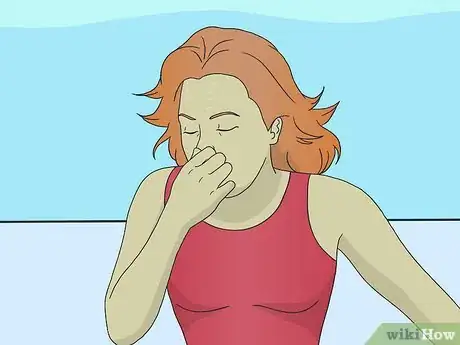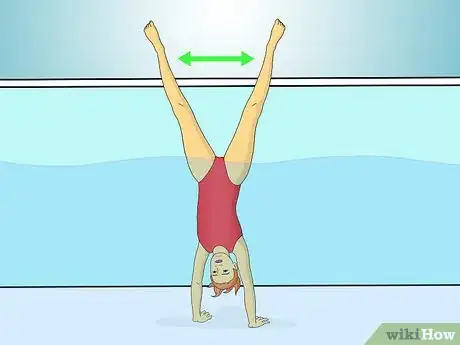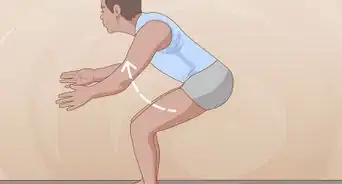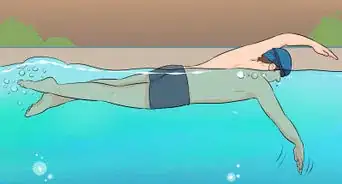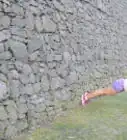X
wikiHow is a “wiki,” similar to Wikipedia, which means that many of our articles are co-written by multiple authors. To create this article, 37 people, some anonymous, worked to edit and improve it over time.
This article has been viewed 65,547 times.
Learn more...
Doing a handstand on land can be very difficult and tricky, maybe even impossible for some people. Doing a handstand in the water, however, is a lot less difficult and can be a tremendous amount of fun. If you have a pool, or there is a lake or calm body of water in your area, you can begin teaching yourself how to do a handstands underwater.
Steps
Method 1
Method 1 of 2:
Learning How to do a Handstand in Water
-
1Stand in shallow water. It is easier to do a handstand in shallow water, but you want the water to be shallow enough that your legs & feet will be up in the air. If you try to do a handstand in water that is too deep, you may have a problem keeping your hands planted on the bottom of the pool or body of water.
- Be sure that nobody is close to you. In case you tip over, you don't want to accidentally kick anyone in the face.
- Try moving into deeper water if you find it difficult to do a handstand. This will make your body feel lighter.
-
2Take a deep breath. The longer you can hold your breath, the more time you will have to practice your handstands while underwater. You may want to practice holding your breath a few times before diving into the pool or lake.Advertisement
-
3Dive straight down while tucking your legs to your chest. Sometimes it is easier to kick one of your feet off the pool.
-
4Plant your hands. When you plant your hands, be sure to keep them at least shoulder length apart. The farther apart you can plant your hands, the more stable you will be.
- Aim to plant your hands where your feet started, this will help get all of your weight directly above you.
- Try spreading your arms out a bit more if you are having problems performing a handstand.
- The same with your fingers. The wider your can spread them when you plant your hands, the more stable of a base you will create.
-
5Straighten your body and legs. Keeping your hands firmly planted, untuck your legs from your torso and begin extending them up toward the sky.
- For some people, it is easier to gain their balance if they straighten their bodies quickly.
-
6Hold your legs and feet together tightly. If you have difficulty holding your legs and feet together, try crossing your legs at the ankles.
- Try to keep your spine straight, directly inline with your legs.
- Remember to keep your legs straight. The straighter and closer together you can keep them, the easier it will be to maintain a handstand.
-
7Point your toes high up. Pointing your toes up to the sky will help you keep your legs straight, and will also help you maintain your balance.
-
8Hold the stand for as long as you can. Remember to keep your legs together and your toes pointed. Once you're upside-down, keep your neck & head straight, looking forward, rather than looking at the bottom of the pool. This will keep your body straighter, and make it easier to maintain your balance.
- Try to imagine that you are not only standing on your hands, but that you are trying to push yourself upward with every muscle of your body. Extending your muscles will help you gain your balance.
Advertisement
Method 2
Method 2 of 2:
Doing a One-Handed Handstand in Water
-
1Perform and hold a two-handed handstand in water. After you have learned how to hold a two-handed handstand in water, you are now ready to start learning how to do one-handed handstands.
- Learning to do a one-handed handstand can be a lot more difficult and take a lot more time to learn than a two-handed handstand.
- Be patient.
-
2Spread your legs apart. While holding a two-handed handstand, begin to slowly spread your legs apart as far as you can. Remember to keep your back straight and extend your muscles.
- Don't stretch the legs too far, instead, only spread them to a point that is comfortable.
- The wider you can stretch your legs, however, the more easier it will be to find your balance due to a lower center of gravity.
- You may have to move to shallower water if you can spread your legs far enough that your feet begin to dip.
-
3Shift your weight to the side. If you are planning on doing a one-handed handstand on your right hand then you should shift your weight to your right side.
-
4Hold your hips at 9 and 2 o'clock. If you are holding your weight on your right side, your right hip should be tipped toward the ground (the 2 o'clock position), and your left hip should be extended outward (the 9 o'clock position).
- Try to imagine a straight line between the shoulder you will be standing on, and the opposite hip.
-
5Lift your palm. Bending the elbow on the arm you will not be hand standing on, lift your palm off the ground so that you come to rest on your fingertips.
- Try to maintain the straight line between your support shoulder and opposite hip.
-
6Fold each finger in toward your palm, one at a time. Begin with your pinky, then the ring and middle fingers, and then the thumb. You should now be supporting your weak hand with only your pointer finger.
- Depending on how strong your fingers are, this may take quite a bit of practice.
- If using one finger is uncomfortable, you can try skipping the last finger and going directly into the one-handed handstand.
-
7Bend the elbow and lift the arm. Be careful not to swing your arm out, but instead, be sure to bend your elbow so that it draws your hand up closer to the shoulder. This will help you keep your balance.
- Try lifting the hand straight up to your shoulder. This will help you keep your center of balance.
-
8Hold your arm and shoulder in place and straighten the elbow. Your arm should now be extended outward to your side.
- Try to keep your elbow locked. This will help stabilize the arm and make it easier to maintain your balance.
- Remember to extend all of the muscles in your body. This will help you stabilize yourself.
Advertisement
Community Q&A
-
QuestionCan you do a cartweel with no hands on the ground?
 Community AnswerYes. It is called an aerial, but it is very difficult.
Community AnswerYes. It is called an aerial, but it is very difficult. -
QuestionCan I do a handstand without opening my legs?
 Community AnswerYes, you can!
Community AnswerYes, you can! -
QuestionHow do I come down from a handstand?
 Community AnswerJust bring your legs down slowly, then pull your head up. You won't ever hurt yourself because the water will float you to the surface, unless you force yourself down.
Community AnswerJust bring your legs down slowly, then pull your head up. You won't ever hurt yourself because the water will float you to the surface, unless you force yourself down.
Advertisement
Warnings
- Make sure that you have enough space around you to avoid kicking someone as you go upside-down, or hitting someone with your legs if you lose your balance and fall over.⧼thumbs_response⧽
- If you begin to feel breathless, stop immediately! You don't want to faint & drown.⧼thumbs_response⧽
Advertisement
Things You'll Need
- A swimsuit or a change of clothes
- A nose clip if you don't like water up your nose
About This Article
Advertisement

